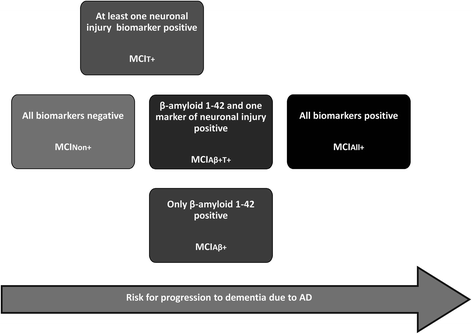Conflicting cerebrospinal fluid biomarkers and progression to dementia due to Alzheimer's disease
- PMID: 27931251
- PMCID: PMC5146856
- DOI: 10.1186/s13195-016-0220-z
Conflicting cerebrospinal fluid biomarkers and progression to dementia due to Alzheimer's disease
Abstract
Background: According to new diagnostic guidelines for Alzheimer's disease (AD), biomarkers enable estimation of the individual likelihood of underlying AD pathophysiology and the associated risk of progression to AD dementia for patients with mild cognitive impairment (MCI). Nonetheless, how conflicting biomarker constellations affect the progression risk is still elusive. The present study explored the impact of different cerebrospinal fluid (CSF) biomarker constellations on the progression risk of MCI patients.
Methods: A multicentre cohort of 469 patients with MCI and available CSF biomarker results and clinical follow-up data was considered. Biomarker values were categorized as positive for AD, negative or borderline. Progression risk differences between patients with different constellations of total Tau (t-Tau), phosphorylated Tau at threonine 181 (p-Tau) and amyloid-beta 1-42 (Aβ42) were studied. Group comparison analyses and Cox regression models were employed.
Results: Patients with all biomarkers positive for AD (N = 145) had the highest hazard for progression to dementia due to AD, whilst patients with no positive biomarkers (N = 111) had the lowest. The risk of patients with only abnormal p-Tau and/or t-Tau (N = 49) or with positive Aβ42 in combination with positive t-Tau or p-Tau (N = 119) is significantly lower than that of patients with all biomarkers positive.
Conclusions: The risk of progression to dementia due to AD differs between patients with different CSF biomarker constellations.
Keywords: Alzheimer’s disease; Cerebrospinal fluid; Mild cognitive impairment; Prognosis.
Figures



References
-
- McKhann GM, Knopman DS, Chertkow H, Hyman BT, Jack CR, Kawas CH, et al. The diagnosis of dementia due to Alzheimer’s disease: recommendations from the National Institute on Aging-Alzheimer’s Association workgroups on diagnostic guidelines for Alzheimer’s disease. Alzheimers Dement. 2011;7:263–9. doi: 10.1016/j.jalz.2011.03.005. - DOI - PMC - PubMed
-
- Scheltens P, Blennow K, Breteler MMB, de Strooper B, Frisoni GB, Salloway S, Van der Flier, Wiesje M. Alzheimer’s disease. Lancet. 2016. doi:10.1016/S0140-6736(15)01124-1. - PubMed
Publication types
MeSH terms
Substances
Grants and funding
LinkOut - more resources
Full Text Sources
Other Literature Sources
Medical

